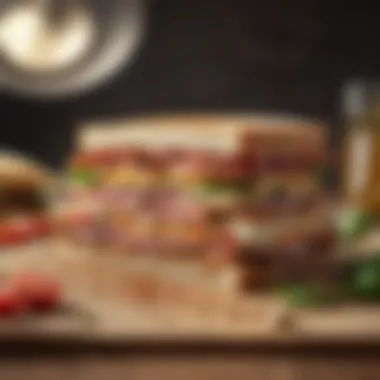Crafting the Perfect Sandwich: A Comprehensive Guide


Intro
In the culinary world, sandwiches often get a bad rap. Too often they're pigeonholed as a quick fix for lunch or a simple afterthought. However, a well-crafted sandwich can offer a symphony of flavors and textures that elevate this humble dish into something truly special. Whether you’re enjoying it in a bustling café or packed in a lunch box, the art of sandwich-making invites creativity and personal expression.
Sandwiches have roots stretching deep into history, with various cultures putting their own spin on this basic concept. From the ancient Romans and their bread-and-filling creations to today’s gourmet spins featuring artisan breads and locally sourced ingredients, the potential is virtually limitless. Many people view a sandwich as merely a collection of ingredients slapped between two pieces of bread, but crafting the perfect sandwich is about balance, harmony, and an understanding of each component's role in the overall dish.
In this comprehensive guide, we dive into the nitty-gritty of sandwich construction. The sections to follow will cover recipe overviews, step-by-step instructions, and insightful tips from choosing the right ingredients to mastering preparation techniques. This isn't just a guide about making sandwiches; it's about creating an experience that resonates with your personal tastes and lifestyle. Join us as we uncover the art that one can pour into making a dish that, at its core, is deceptively simple but can be anything but.
Prelude to Sandwich Making
Sandwich making is more than a simple task; it's a craft that combines various techniques, ingredients, and a bit of creativity. This subject matters because it reflects cultural nuances, personal preferences, and even culinary traditions. A well-constructed sandwich offers nourishment, comfort, and joy in every bite. Through exploring this guide, one can not only learn to assemble a sandwich but also appreciate the art behind it.
The beauty of sandwiches lies in their versatility. With countless combinations of ingredients and styles, anyone can find a concoction that suits their palate. For busy individuals, mastering the essentials of sandwich making means having a quick yet satisfying meal option at hand – something that holds great value in our fast-paced lives.
"A sandwich not only satisfies hunger, but it can also evoke brilliance in flavor combinations and creativity."
In this journey, we will explore several facets of sandwich creation. From understanding the historical background that paved the way for your favorite lunch staple to the essentials of selecting quality ingredients, each aspect holds significance in crafting that perfect bite. Moreover, it's crucial to understand the techniques that will ensure a stable and flavorful sandwich. Comprehending these elements enhances not only the experience of making sandwiches but also elevates the act into a respected culinary adventure.
A Brief History
The history of sandwiches is as layered as the creation itself. Sandwiches claim to have roots dating back to the 18th century when John Montagu, the Fourth Earl of Sandwich, inspired the term. Allegedly, he requested meat tucked between two slices of bread while engrossed in a card game, leading to a convenient meal that allowed him to continue playing.
However, this culinary delight is not solely a product of British influence. Various cultures have produced their own sandwich-like delicacies long before the term "sandwich" existed. In Middle Eastern cuisine, for example, flatbreads filled with meats and vegetables have gratified appetites for centuries. Each region left its mark, creating a diverse landscape of sandwich options across global cuisine. Understanding this historical backdrop enriches one’s appreciation for different styles and interpretations, allowing for a deeper connection to the craft.
Understanding the Basics
Before venturing into the complexities of gourmet creations, it's important to grasp the fundamental elements of a sandwich. A basic sandwich typically consists of three major components: bread, filling, and toppings. However, each aspect demands attention and quality to ensure balance and delightful flavors.
- Bread: The foundation is critical. The choice of bread can dramatically affect the overall experience. Some people prefer the hearty structure of whole grain while others choose the tanginess of sourdough.
- Filling: When it comes to fillings, the possibilities abound. Cold cuts, fresh meats, or even plant-based proteins cater to varying dietary preferences. This component can set the tone for the entire sandwich.
- Toppings: The cherry on top. Fresh vegetables, cheeses, and sauces transform a simple creation into a masterpiece. The layering of flavors and textures plays a significant role in a satisfying sandwich.
Understanding these elements is crucial for anyone looking to make their mark in the world of sandwiches. With these basics in mind, we can now delve deeper into how to select the right ingredients that will enhance each layer of the sandwich.
Selecting the Right Ingredients
When it comes to building a sandwich that truly stands out, the selection of ingredients plays a pivotal role. It's not merely about slapping together some bread, meat, and veggies; they are the key players that define not only the flavor but also the overall experience of the sandwich. Choosing the right components can elevate a standard meal into a delightful journey of taste, texture, and nutrition, making it essential to understand the myriad options available.
Bread Types and Their Characteristics
Whole Grain Options
Whole grain breads have become increasingly popular in the world of sandwiches, thanks to their nutritional prowess. They are crafted from the entire grain kernel, leaving in the Bran, germ, and endosperm. This amalgamation not only gifts a nuttier flavor profile but also provides essential nutrients, including fiber. The presence of fiber aids in digestion, ensuring you feel fuller for a longer period, which can be particularly advantageous for those with busy schedules.
However, a consideration here is the texture; while whole grain varieties might feel denser, they also offer a sturdiness that can withstand a hearty filling. Yet, some might find them less appealing due to their heavier bite.
Sourdough Versatility
Sourdough bread is celebrated for its distinct tangy flavor, which results from the fermentation process. This type of bread is exceptionally versatile, pairing beautifully with various sandwich fillings, whether it's sweet or savory. The crusty exterior and chewy interior contribute a delightful contrast to the softer ingredients.
One unique characteristic of sourdough is its longer shelf life, given its acidic nature which helps inhibit mold growth. However, this tanginess may not suit everyone’s palate. Some find it exhilarating, while others may be turned off by its pronounced flavor.
Baguettes and Rolls
Baguettes and rolls, renowned for their crispy crust and soft interior, offer another dynamic aspect to sandwich construction. The primary advantage of bread types like these is their ability to be easily customized and portioned. A classic French baguette can hold multiple fillings, enhancing the layers of flavor.
The disadvantage, however, comes into play if the filling is watery or too heavy—one might end up with soggy bread. Thus, modifying the filling's moisture content while keeping texture in mind is crucial.
Choosing Quality Proteins
Cold Cuts vs. Fresh Meats


Quality proteins are the backbone of any sandwich. Cold cuts, such as turkey or ham, offer convenience and have a long shelf life, making them an attractive option for those who want to build a quick lunch. Moreover, cold cuts often come pre-seasoned, providing an instant flavor experience.
Yet, it's essential to consider the nutritional content; some cold cuts can be high in sodium and preservatives. In contrast, fresh meats offer a more robust, flavorful choice, bringing a different level of satisfaction. Their advantage lies in customization; you can marinate and cook them to your liking, creating a delightful sandwich experience tailored to individual preferences.
Vegetarian Protein Sources
As the culinary world shifts towards more plant-focused diets, vegetarian protein sources like chickpeas, lentils, and tofu have made a significant mark in sandwich making. These ingredients not only provide substantial protein but are also loaded with nutrients that enhance overall health.
For example, chickpea salad can be a festive filling packed with flavor and vibrancy. The challenge might be some people may not find vegetarian options as satisfying as their meat counterparts. Finding the right balance of flavors and textures is essential in this category to ensure it remains appealing.
The Importance of Vegetables
Fresh vs. Pickled
Vegetables bring a crucial freshness to sandwiches. The choice between using fresh or pickled vegetables can make or break the taste of your creation. Fresh vegetables, like lettuce and tomatoes, provide crunch and juiciness. They often carry a crispness that can lighten the heaviness of other ingredients.
On the flip side, pickled vegetables add a tangy kick that can elevate the overall flavor profile. Ingredients like pickles or sauerkraut frequently add complexity, offering an acidic contrast to richer fillings. However, it’s important to note that while pickled vegetables boast longer shelf lives, not every palate enjoys their sour notes.
Leafy Greens and Crunchy Additions
Incorporating leafy greens and crunchy ingredients elevates a sandwich by adding texture and nutrition. Spinach, kale, and arugula can offer essential vitamins and a fresh taste that perfectly balances hearty proteins and spreads. The contrast in textures, with crunchy elements like cucumbers or peppers, can create an engaging eating experience, one that invites the palate to explore.
But selecting the right crunchy additions is essential. Too much crunch can overpower softer fillings, while too little may not deliver the intended impact. Finding that balance is key while crafting your sandwich masterpiece.
Condiments and Spreads: Enhancing Flavor
Classic Options
When we dive into condiments, classic options like mayonnaise, mustard, and ketchup instantly spring to mind. These staples bring familiarity and ease to any sandwich-making process. Mayonnaise lends creaminess, while mustard offers a delightful kick, setting a balanced stage for other flavors. However, being careful not to oversaturate is imperative; too much can lead to a soggy mess.
Experimental Flavors
Experimenting with flavors can unveil a world of possibilities. From spicy harissa to tangy kimchi, blending bold options can elevate the mundane into an extraordinary culinary experience. These unconventional spreads often provide unexpected bursts of flavor, turning a simple sandwich into an adventure. The challenge lies in ensuring these flavors harmonize. Misjudging balances may create a discordant flavor profile, leading to an unappealing outcome.
By carefully selecting and understanding each ingredient, makers can build sandwiches that don’t merely fill the stomach but also delight the senses. Each component is integral, working together to form a complex, enjoyable meal that appeals to varied tastes and preferences.
Techniques for Preparation
The art of sandwich-making wouldn’t be complete without exploring the techniques that elevate a mere collection of ingredients into a scrumptious creation. Each technique serves a purpose, augmenting flavor, texture and ensuring your sandwich holds up whatever filling you choose. As a culinary enthusiast, understanding these methods is key to making sandwiches that impress on every count. Let's dive deeper into how to prepare your sandwich like a pro.
Layering for Stability
Layering a sandwich correctly is not just about aesthetics; it’s about ensuring that every bite is balanced and delightful. Imagine sinking your teeth into a sandwich, only to have half of it slide out onto your plate. That's a recipe for disappointment. So, how do you avoid this culinary faux pas?
- Bottom to Top Approach: Start with heartier ingredients at the bottom, such as lettuce or tomatoes, which can soak up moisture without losing firmness. This base acts like a barrier, protecting the bread from becoming soggy.
- Strategic Protein Placement: Next, place your protein. Whether it’s turkey slices, grilled veggies, or a thick slab of tofu, ensure it’s evenly distributed. It helps bind everything, making the sandwich robust.
- Condiments with Care: Spread condiments sparingly between layers. Too much sauce can create a slippery mess. Instead, consider layering on the outer edges of your sandwich, ensuring the filling remains intact.
A well-layered sandwich not only prevents a disaster on the plate but also ensures that every bite offers a delightful mix of flavors and textures.
Toasting and Grilling
The crunch of a toasted sandwich is undeniably gratifying, but beyond the delightful sound is a world of flavor enhancement. Toasting and grilling bring a new dimension to your ingredients. By applying heat, you can create that crisp edge while locking in juices that enhance the overall taste.
When toasting, consider:
- Bread Type Matters: Bread with a firm crust to begin with will hold up better and toast more evenly. Sourdough, for example, gives character and stands strong during the grilling process.
- Even Heating: Be mindful of getting that golden-brown exterior. Keep the heat at a medium setting to ensure that one side doesn’t get burnt while waiting for the other side to catch up.
For those looking to amp up their grilling game, a panini press can work wonders. This device evenly applies pressure and heat, leading to a perfect melt of cheese and an infusion of flavors from your fillings.
Balancing Flavors and Textures
Finding that sweet spot with flavors and textures is crucial in sandwich-making. A balanced sandwich delights the palate, combining the savory, sweet, crunchy, and creamy elements in harmony. A lack of balance can lead to either a boring or overwhelming bite.


- Contrasting Textures: Add crunch with pickles, raw bell peppers, or even crispy bacon. This provides a compelling contrast to creamy elements like avocado or mayonnaise.
- Flavor Profiles: Pairing bold flavors, like spicy mustard with a milder turkey, ensures the sandwich is not one-note. Instead, it should sing with complexity.
- Consider the Seasoning: Sometimes, just a pinch of salt or a dash of pepper can help bring out hidden flavors. Don’t forget to taste as you build, adjusting as needed to establish that perfect balance.
Incorporating these techniques into your sandwich-making process not only enhances the overall experience for both the maker and the eater, but it transforms a simple meal into a centerpiece worth celebrating.
Customization for Various Diets
Crafting a sandwich that appeals to diverse dietary preferences is essential in today’s culinary landscape. People are more conscious than ever about what goes into their bodies, turning dietary requirements into decisive factors when enjoying a meal. Customizing sandwiches for different diets not only engages the taste buds but also fosters inclusivity and creativity in the kitchen. This section will explore how different dietary considerations can be harmonized into delicious sandwiches, capturing both flavor and nutrition.
Sandwiches for Meat Lovers
When it comes to sandwiches for meat lovers, the options are as vast as they are delicious. From succulent cuts of beef to savory slices of bacon, the meat-centric sandwich can be a tribute to carnivorous indulgence. The key here is not just finding quality meat but also complementing it with ingredients that enhance its flavor profile.
- Choosing the Right Meat: Whether it's freshly roasted turkey, spicy sausage, or classic pastrami, opt for meats that provide a rich flavor without excess fat. Go for freshly sliced, high-quality options from your local deli when possible.
- Layering Savory Flavors: Pair meats with bold cheeses like aged cheddar or smoky gouda. Adding rich condiments such as horseradish or a tangy barbecue sauce can elevate the taste experience dramatically.
- Textures Matter: Don't forget to incorporate crunchy elements. Crispy fried onions or pickles can create that satisfying crunch that complements the softness of the meat while balancing the flavors.
In essence, the blend of textures and flavors, paired with fresh ingredients, will create a meat lover's sandwich that could make anyone’s mouth water.
Vegan and Vegetarian Sandwiches
Switching gears from meat-centric options, vegan and vegetarian sandwiches offer a wealth of variety and flavor without animal products. The possibilities are endless, enabling creative use of vegetables, legumes, nuts, and grains.
- Focus on Fresh Ingredients: Using seasonal vegetables like roasted bell peppers, ripe avocados, or zesty sprouts can add depth and brightness. Grains like quinoa or farro can also serve as hearty fillers, providing ample protein without meat.
- Creative Spreads: Instead of traditional mayonnaise or butter, consider hummus, avocados, or nut butters that not only add creaminess but also pack a nutritional punch.
- Flavor Layers: Complement veggies with herbs like basil or mint, and spices such as smoked paprika or curry powder to enhance the flavor. Peppers or lemon juice can add zing that tantalizes the palate.
Ultimately, the joy derives from the creativity involved. Minimalism with bold flavors can lead to sandwiches that are anything but bland.
Gluten-Free Options
In an era where gluten sensitivity has become increasingly common, providing gluten-free sandwich options is crucial. Yet, this doesn’t mean sacrificing flavor or satisfaction.
- Bread Alternatives: Explore options such as gluten-free breads made from rice flour or almond flour. Lettuce wraps or portobello mushrooms can also serve as creative substitutes.
- Rich Fillings: Focus on filling options that are naturally gluten-free. Think roasted vegetables, grilled chicken, or chickpea salad. Make use of sauces that are labeled gluten-free to avoid cross-contamination.
- Testing Texture: Texture plays a vital role, making it essential to mix creamy and crunchy elements. Adding toasted nuts or seeds not only enhances the flavor but also delivers a satisfying crunch that offsets softer fillings.
Incorporating gluten-free options ensures that nobody is left out of the sandwich fun, allowing all diners to relish in the shared experience.
"Customization in sandwich making opens doors to creativity while catering to personal tastes and dietary needs. It's an art as much as a necessity!"
By personalizing sandwiches according to dietary preferences, everyone can feast on a delightful creation that respects their nutritional choices, turning a simple meal into a memorable experience.
Perfecting Presentation
In the world of culinary arts, the saying goes that you eat with your eyes first. This rings especially true in sandwich crafting. Presentation is not only about making your dish look good; it’s an intrinsic part of the eating experience. The visual appeal sets the stage for flavor expectation and can transform an ordinary meal into an extraordinary experience. Each layer should be thoughtfully arranged, ensuring that colors, textures, and shapes complement one another. Let’s dive deeper into the aspects of cutting techniques and creative plating ideas that can markedly improve the presentation of your sandwich.
Cutting Techniques
The way a sandwich is cut can drastically alter its presentation. A beautifully cut sandwich enhances the visual appeal and makes it more inviting. Here are some common techniques to consider:
- Diagonal Cut: Cutting a sandwich diagonally not only makes it look appealing but can also make it easier to hold and eat. One can see the layers of fillings better, showcasing the flavors packed inside.
- Quartering: If the sandwich is large, quartering it can serve well. This method provides multiple bite-sized portions, making it perfect for sharing. Plus, it adds a touch of elegance to the dining experience.
- Remove the Crusts: For those wanting that childhood classic vibe or serving children, removing the crusts makes the sandwich look more delicate and appealing. This can be particularly effective with softer bread.
- Use of Decorative Cuts: Employing shapes like triangles, squares, or even using cookie cutters can add a whimsical element to your presentation. It's an interesting way to personalize your sandwich for special occasions.
It’s clear that cutting techniques play a significant role in setting the tone of your sandwich presentation. Depending on the occasion, opting for different styles might just be the game-changer you need. Remember, a clean cut is always more visually appealing than a messy one. A well-executed cut leaves a good impression and builds anticipation.
Creative Plating Ideas
Now that we've covered the cuts, let’s talk about how to place these sandwiches onto the plate. Creative plating can elevate a simple dish to a stunning presentation that surpasses the ordinary. Here are some innovative ideas:
- Layering with Ingredients: Instead of slapping your sandwich down flat on a plate, consider using height. Layer ingredients in a way that some elements lean against each other. For instance, stack small side salads or condiments beside your sandwich for a vibrant look.
- Garnishes: Fresh herbs or edible flowers can dramatically affect the aesthetic of your dish. Placing a sprig of basil or a few microgreens beside your sandwich creates a livelier presentation.
- Utilization of Serving Boards: Consider arranging your sandwiches on wooden or slate boards instead of traditional plates. A rustic wooden board lets the colors of the sandwich shine and feels approachable.
- Color Contrast: Choose serveware that complements the colors of your sandwich. A bright slice of beetroot on a green plate can turn heads, while a sandwich with various layers can be showcased on a white plate for a clean finish.
"Presentation can convert a meal into a work of art, inviting diners to take a closer look and enjoy their food with all senses."
All these techniques help in transforming your sandwich into more than just a meal. They convey care and creativity, ensuring that the experience is memorable. So, as you craft your perfect sandwich, remember: the beauty lies in the details.
Accompaniments
In the realm of sandwiches, the main act often gets all the attention. However, the accompaniments can make a hearty difference, transforming a simple meal into a memorable culinary experience. Think of accompaniments as the supporting cast in a theater production; without them, even the best sandwich can feel lacking. They serve to enhance flavors, introduce contrasting textures, and even add a dash of color to the plate, which can be essential in elevating the overall presentation.


Chips and Sides
When it comes to sides, chips are a classic companion to any sandwich. Crunchy, salty, and often packin a flavor bump, they make for a delightful contrast to the soft, chewy bread of your sandwich. Think about it. You take a big juicy bite of a BLT and then crunch down on some kettle-cooked chips. The textural difference is enough to make your mouth dance with joy.
When selecting chips, originality matters. Instead of opting for run-of-the-mill potato chips, consider flavored varieties like chimichurri, taco, or even seaweed-based crisps. For those who wish to tread the healthier path, homemade vegetable chips can be another great option. Simply slice zucchini or beetroot thinly, toss them in a bit of olive oil, and bake until they are crispy.
Accompanying your sandwich with a fresh salad can also be a winning choice. A simple Cucumber and Tomato Salad, with a drizzle of olive oil and a sprinkle of salt, can serve as a refreshing side that balances the richness of a sandwich filled with meats or cheeses. Coleslaw, with its creamy texture and slight tang, has a way of revitalizing your palate between bites.
- Options for Chips and Sides:
- Kettle-Cooked Chips (flavored)
- Homemade Vegetable Chips
- Fresh Salad (Cucumber and Tomato)
- Coleslaw with a tang
Beverage Pairings
The right drink can power up your sandwich experience. Beverage pairing isn’t just about complementing flavors; it's about creating a complete dining experience. A well-thought-out pairing can serve to enhance the taste of your meal and cleanse your palate.
For a classic sandwich such as a Ham and Cheese, it’s hard to beat a glass of Iced Tea—the slight tannic bitterness cuts through richness beautifully. On the other hand, a crisp Limonade can invigorate a heavier sandwich like a Pulled Pork option, refreshing the taste buds and keeping things light.
For those who enjoy a touch of fizz, Sparkling Water paired with a slice of lemon can provide a delightful, effervescent counterpoint, especially when paired with a Caprese Sandwich. Other imaginative choices include a fruit-infused Mocktail, which can be both non-alcoholic and refreshing.
For the more adventurous, consider pairing sandwiches with regional beers that bring their own unique flavors into the mix. A IPA can work wonders with bold flavors, while a Wheat Beer pairs nicely with lighter sandwiches.
- Beverages to Consider:
- Iced Tea with Ham and Cheese
- Lemonade with Pulled Pork
- Sparkling Water with Caprese
- Fruit-Infused Mocktail
- Regional Beers for bold flavors
In the world of sandwich-making, every element matters. The right sides and beverages can elevate even the most humble sandwich to gourmet status.
By selecting thoughtful accompaniments, you’re not just adding a side dish—you’re rounding out a meal that leaves a lasting impression, showcasing a careful consideration for flavor and experience. Accompaniments play a big role in enhancing not only the sandwich's taste but also the overall enjoyment.
Sustainability in Sandwich Making
In today's world, a growing consciousness around environmental issues urges us to examine our food choices more closely, including something as straightforward as a sandwich. Sustainability in sandwich making goes beyond simply choosing organic lettuce or whole grain bread. It envelops a holistic approach to food sourcing, consumption, and waste management, aiming to lower our ecological footprint while indulging in delicious culinary creations. Having sustainability at the forefront offers not just environmental benefits, but also encourages a deeper connection with our food.
The long-term advantages of engaging in sustainable practices are numerous. For starters, utilizing local ingredients not only provides fresher options but also supports the local economy and reduces carbon emissions linked to transporting food over long distances. Each bite of your sandwich becomes a small celebration of the community’s produce.
Moreover, considering sustainability can enhance the appeal of your sandwiches. Diners today are more inclined to appreciate meals that feel responsible and conscientious, leading to not just better eating habits but also an enriched dining experience. A commitment to sustainable ingredients and practices offers a chance for makers to distinguish their offerings in an increasingly crowded market.
"Eating sustainably is not just a trend; it’s a necessity for both our health and the planet’s future."
Choosing Local Ingredients
The practice of using local ingredients manifests more than just a trend; it represents a pivotal shift in how we approach food and cooking. Local ingredients have a shorter journey from farm to table, meaning they retain more nutrients and flavor. This chain of custody has clear advantages, and when applied to sandwich making, the impact can be substantial.
- Freshness: The taste of a tomato picked that morning from a nearby farm will shine through in a sandwich, far surpassing the flavor of one that travelled hundreds of miles.
- Seasonal Variability: Working with local produce allows for a menu that changes with the seasons. This not only stimulates creativity in sandwich assembly but also encourages diners to experience food in its freshest form, promoting a more varied and interesting diet.
- Cultural Relevance: Utilizing local ingredients can connect a sandwich to the culture and traditions of the area, giving it an identity that reflects regional tastes and practices.
Considering the environmental benefits of local sourcing is crucial. It reduces transport emissions and often supports sustainable farming practices. When forming your perfect sandwich, look to your community—farmers' markets, local co-ops, or direct supply from farms can unearth delicious, vibrant, and sustainable options.
Waste Reduction Techniques
To truly embrace sustainability, waste reduction techniques are vital in sandwich making. Not only can these methods enhance efficiency in the kitchen, but they can also lead to more thoughtfully composed food. Here are some strategies to consider:
- Repurposing Leftovers: Any leftover ingredients from one sandwich creation can easily become the star of another. For instance, bits of roasted vegetables can make a delightful addition when paired with fresh greens, and stale bread can find new life as croutons.
- Smart Ingredient Usage: Be conscious about using entire ingredients wherever possible. For example, vegetable peels and ends can be incorporated in stocks or composted. This practice not only minimizes waste but can also be economical.
- Controlled Portions: Making sandwiches in calculated sizes can help in managing how much food is needed, thus reducing excess waste. Encourage diners to create custom sandwiches with a selection of fillings that allow them to indulge without leaving any food to be discarded.
A sustainable approach challenges both home cooks and restaurateurs to rethink their relationship with food. The choices made in sandwich construction can reflect broader values and habits that contribute to a healthier planet. By implementing local sources and focusing on waste reduction, we can turn the humble sandwich into a powerful tool for change in our culinary practices.
End
Crafting a well-rounded sandwich is an art form that goes beyond merely stacking ingredients between two slices of bread. The versatility of sandwiches speaks volumes about their importance in both culinary culture and daily life. This article has explored various facets of sandwich-making, emphasizing that every component can transform a simple dish into something memorable.
The Versatility of Sandwiches
The beauty of sandwiches lies in their adaptability. They cater to diverse tastes and dietary requirements, making them a beloved choice worldwide. Whether one desires a hearty meat lover's creation or a colorful vegan option, sandwiches can be tailored to suit any palate. It’s not just about what you put between the bread; it’s about creating a harmonious blend of flavors, textures, and colors.
- Cultural Expression: Each culture has its own take on sandwiches, from the French baguette filled with rich ingredients, to the American deli-style beast stacked high with meats. They often tell a story, reflecting regional preferences and flavors.
- Dietary Flexibility: Sandwiches can be enjoyed by virtually anyone. You can have gluten-free wraps, intriguing vegan spreads, or loaded versions for those who crave a feast. This adaptability opens the doors to creativity—there are no boundaries when it comes to flavors.
- Meal Convenience: Today's busy lifestyles demand meals that are both quick and satisfying. Sandwiches can be prepped in advance or assembled in just a few minutes, making them the go-to choice for a packed lunch or quick dinner.
- Nutritional Balance: With careful ingredient selection, sandwiches can be nutrient-rich. Incorporating fresh vegetables, wholesome grains, and quality proteins ensures that your sandwich can be as healthy or indulgent as desired.
- Social Aspect: Often seen at picnics, gatherings, and events, sandwiches bring people together. The act of sharing a meal fosters connection and conversation. Each creation can become a talking point, encouraging exchanges about favorite ingredients and unique preparations.
In sum, the versatility of sandwiches offers infinite possibilities for culinary exploration. It's not just about feeding hunger; it's about the joy of creating something personal and delightful. Understanding this balance can elevate your sandwich-making skills from ordinary to extraordinary.







